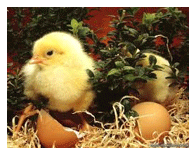Animal Welfare in Poultry (Part III)
Published: August 13, 2014
By: Tean Zaheer (DVM student FVS, UAF)
Animal rights versus animal welfare have been discussed in the previous articles. This article ramifies the implementation of certain laws and regulations being adopted in different countries internationally in specific relation to the Commercial Industry. Purposely, not only encouraging these laws but also working on the possible ways of their grass roots implementations in the developing countries also. The welfare code for slaughtering the commercial animals and poultry has been discussed in reference to Animal Welfare as under.
- Federation of Veterinarians of Europe (FVE) Regulation:
The regulation addresses the veterinarians as the special care takers of companion animals, commercial animals and livestock, also it appreciates their roles in improving food hygiene and therefore, public health. The observer of the regulation being Ukraine, includes 35 other member countries in which the regulation is applicable.
FVE is of the opinion that from an animal welfare point of view, the stress during and before slaughter should be eliminated and effective stunning methods may be used to minimize the pain. Out of respect of an animal as a sentient being, the practice of slaughtering animals without prior stunning is unacceptable under any circumstances.
- Animal Welfare (Layer Hens) Code of Welfare 2012:
This code sets the minimum standards for the care and management of layer hens under all forms of management used in New Zealand. The purpose of this code is to provide guidance to the owners of layer hens and to persons who are in charge of them about the standards they must achieve in order to meet their obligations under the Animal Welfare Act 1999.
- General precautions in Environment Controlled Housing (ECH):
- Housing facilities: Artificial keeping of birds in Environment Controlled Houses is relatively regarded more beneficial only when natural posture and requirements of the bird are met adequately.

- Controlled environment housing must have alarms that warn of power failure and/or significant temperature variance.
- Housing systems and equipment, including shelters used outside and mechanical equipment, must be designed, constructed and maintained to avoid injury, disease or harm to layer hens.
- All housing systems must be designed to allow hens to maintain a natural posture throughout.

- Providing appropriate light:
- The design, size and maintenance of the openings and doors of housing systems must be such that hens can be placed in or removed from them without injury or distress.
- Chicks and pullets housed under artificial light must be exposed to short periods of darkness after placement, in order to train them to blackout conditions should lighting fail.

- Ventilation & Humidity:
- Ventilation of housing systems must be sufficient to prevent the build-up of heat, humidity, dust or noxious gases to levels that are harmful to hen health or that cause pain or distress to hens.
- Temperatures inside housing systems must be maintained within a range compatible with good health and welfare of the hens.
- Handling & Restraining of Birds:
- Layer hens, except day-old chicks, must not be picked up or suspended by one leg, the wings or the neck.
- Debilitated hens must be removed and treated or be killed by a humanemethod as soon as possible.
- If the early signs of a disease outbreak are recognized or suspected, or mortalities are greater than expected, appropriate intervention must be undertaken by a suitably qualified persons.
- Birds should be stunned with a current that results in cardiac arrest (International Practice).
- Decapitation (severing the head from the neck and is permitted without prior stunning) is not recommended on welfare grounds, as brain activity and therefore consciousness may continue for up to 2 minutes after decapitation.
- All birds must be effectively bled out before they enter the scalding tank, in case of automated neck cutting in poultry.
- Religious Methods of Slaughter:
- The methods of slaughter carried out by certain believers e.g Jews and Muslims, eliminates the need of stunning and electric shock prior to slaughter. Although the Government would prefer and would encourage that all animals are stunned before both religious and other slaughter (where this is not incompatible with religious beliefs), it recognizes the needs of religious communities and accepts the importance which they attach to the right to slaughter animals for food in accordance with their beliefs.
- Islam supports and encourages Muslims to abide by the animal rights and welfare related issues well defined by the holy book “Quran”. The same is also taught and practiced by the Holy prophet Muhammad Peace Be Upon Him as is indicated in one of His saying on the subject "God calls for mercy in everything, so be merciful when you kill and when you slaughter, sharpen your blade to relieve its pain”. The basic teaching of Islam regarding animal slaughter emphasizes that the Animal should be slaughtered with a sharp object (knife), cut wind pipe, throat and vessels of neck and eventually the blood should be drained as it minimizes the chances of pathogenic contamination and improves the keeping quality of meat as well.
ANIMAL WELFARE IN COMMERCIAL HOUSING OF POULTRY:
Poultry in commercial industry is a multi-billion business round the globe, a large number of birds are kept in commercial houses therefore, the Well-being and welfare of animals housed commercially should be addressed specially. Various housing systems and their comparisons with reference to welfare of poultry have been discussed.
- Types of Housing systems for layers
The majority of commercial layers in the world are kept in confined housing systems with light control, power ventilation and mechanical feeding. The space per hen in cages is very limited, with no space to express natural behaviors like sand bathing and wing flapping. In Europe, to accommodate social concerns about animal welfare, alternative housing systems have been developed to improve the welfare of layers. Hens must have the opportunity to express a range of normal behaviors. These include, but are not limited to nesting, perching, scratching, ground pecking & dust bathing In general, today’s egg producer has the choice of three main housing systems:
- battery cages –small enclosures with welded wire mesh sloping floors.
- barn systems –in which the layers are kept on litter and the birds have freedom to move around within the poultry house.
- free range systems –in which the layers also have access to an outdoor run.
- Battery Cages VS Cage Free Systems:
In this system, Hens feel uncomfortable, due to limited space and many countries have started eliminating this system of keeping birds. Lack of space means a hen confined in a cage will never flap her wings, cannot lie down without touching her cage mates, will never peck at the ground for food, or roll in a dust bath—something hens do for pleasure.
Moreover, a hen confined in a battery cage will never lay her egg in a nest—her strongest instinct.Studies have shown that a hen will work just as hard to access a secluded nesting area as she will to access food and water.
- Cage-Free Systems:
Because of public opposition to battery cage confinement, many egg producers are switching to cage-free systems. These systems generally offer hens a significantly improved level of animal welfare than do battery cage systems, though the mere absence of cages sometime isn’t enough to ensure high welfare.
Unlike battery hens, cage-free hens are able to walk, spread their wings and lay their eggs in nests, vital natural behaviors denied to hens confined in cages. Most cage-free hens live in very large flocks that can consist of many thousands of hens who never go outside. The vast majority of cage-free hens live on farms that are 3rd-party audited by certification programs that mandate perching and dust-bathing areas. These advantages are very significant to the animals involved.
- The cage-free trend in Canada:
In North America, hundreds of universities, restaurants and municipalities have made the switch to using cage-free eggs. The public wants this change! National polls confirm that most Canadians oppose the use of battery cages for laying hens, and the populations in every province surveyed support a legislative ban on the use of battery cages in their province. Cage-free eggs are also being embraced by city councils and schools. Across Canada, numerous communities have shown their support by choosing to serve cage-free eggs in all council-run facilities, and dozens of schools, including some of Canada’s top universities, such as Concordia, Ryerson, Simon Fraser, Victoria and Guelph, have adopted cage-free egg purchasing policies.
The cage-free egg trend has taken root internationally, too. Dozens of major food companies—like Burger King, Safeway, Subway, Quiznos, Denny’s, Wendy’s, Kraft Foods, Sara Lee and Starbucks—use cage-free eggs. Costco and Wal-Mart have made all their private brand eggs cage-free. Food giant Unilever—owner of popular brands like Hellmann’s mayonnaise and Ben & Jerry’s—announced that it will only use cage-free eggs in its products.

- Conclusion:
All of the above are modern trends being adopted for the welfare of animals in the food industry of developed countries. The acts and regulations discussed above are being followed by many of the countries, but there’s still a need of certain amendments and improvements. Furthermore, forceful implementation of these laws at all animal raising countries and markets keeping the provision of on the spot strict penalties for the offenders at the relevant government levels are required.
Related topics
Authors:
Join to be able to comment.
Once you join Engormix, you will be able to participate in all content and forums.
* Required information
Would you like to discuss another topic? Create a new post to engage with experts in the community.
Create a post







.jpg&w=3840&q=75)